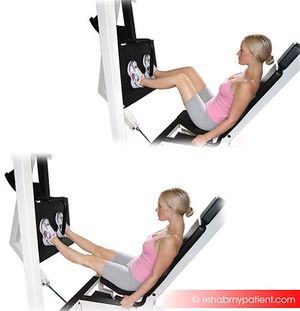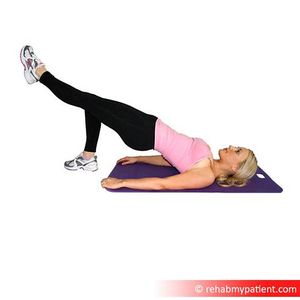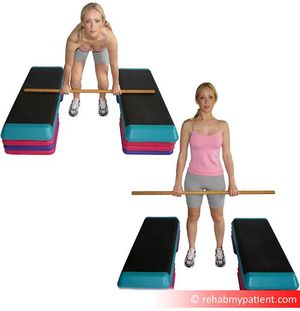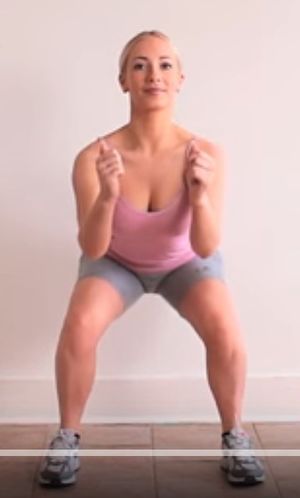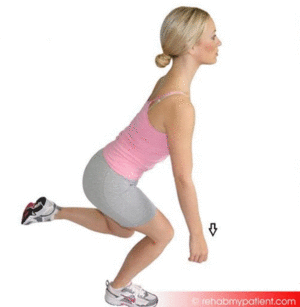ACL Rehabilitation: Rehabilitation Planning: Difference between revisions
No edit summary |
No edit summary |
||
| Line 143: | Line 143: | ||
You can implenment a running program when the athlete achives 90% quadriceps index to make sure the running mechanics will be as close to normal<ref>Lewek M, Rudolph K, Axe M, Snyder-Mackler L. The effect of insufficient quadriceps strength on gait after anterior cruciate ligament reconstruction. Clinical biomechanics. 2002 Jan 1;17(1):56-63.</ref>. The [https://www.ncbi.nlm.nih.gov/pmc/articles/PMC3290923/pdf/ijspt-07-020.pdf Vail sports test] will give you an idea how your patient loads his/her injured knee which will reflect on running<ref name=":3" />. Increasing '''running tolerance''' should be gradual and slow for up to 4 weeks. Alter-G treadmill or pool running is helpful when you want to start with partial weight-bearing, progressing 5% each session till full weigh-bearing. You may begin with 4 minutes of walking to a minute of running repeated 4 times over 20 minutes, 2-3 times per week. Progress each week by increasing a minute of running and decrease a minute of walking, till the athlete is able to run for a progressive 20 minutes. If any signs of overload was present, return to the previous stage of running progression. | You can implenment a running program when the athlete achives 90% quadriceps index to make sure the running mechanics will be as close to normal<ref>Lewek M, Rudolph K, Axe M, Snyder-Mackler L. The effect of insufficient quadriceps strength on gait after anterior cruciate ligament reconstruction. Clinical biomechanics. 2002 Jan 1;17(1):56-63.</ref>. The [https://www.ncbi.nlm.nih.gov/pmc/articles/PMC3290923/pdf/ijspt-07-020.pdf Vail sports test] will give you an idea how your patient loads his/her injured knee which will reflect on running<ref name=":3" />. Increasing '''running tolerance''' should be gradual and slow for up to 4 weeks. Alter-G treadmill or pool running is helpful when you want to start with partial weight-bearing, progressing 5% each session till full weigh-bearing. You may begin with 4 minutes of walking to a minute of running repeated 4 times over 20 minutes, 2-3 times per week. Progress each week by increasing a minute of running and decrease a minute of walking, till the athlete is able to run for a progressive 20 minutes. If any signs of overload was present, return to the previous stage of running progression. | ||
{| width="100%" cellspacing="1" cellpadding="1" | |||
|- | |||
|{{#ev:youtube|njfP29KabO4|300}} <ref>Logan Hutsko - Vail Sport Test. Available from:https://www.youtube.com/watch?v=njfP29KabO4</ref> | |||
|{{#ev:youtube|u0o-8MmKArg|300}} <ref>Demonstration of Anti-Gravity Treadmill at Michigan Medicine. Available from:https://www.youtube.com/watch?v=u0o-8MmKArg</ref> | |||
|} | |||
'''Speed and Agility''' are important for re-conditioning and return to sport. Build a specific drills program depending on your patient's sport-specific needs. | '''Speed and Agility''' are important for re-conditioning and return to sport. Build a specific drills program depending on your patient's sport-specific needs. | ||
Revision as of 14:25, 19 November 2018
Original Editor - Mariam Hashem
Top Contributors - Mariam Hashem, Kim Jackson, Tony Lowe, Jess Bell, Chelsea Mclene, Robin Tacchetti, Tarina van der Stockt, Simisola Ajeyalemi, Wanda van Niekerk, Abbey Wright, Olajumoke Ogunleye, Rachael Lowe and Leana Louw
Page is under work:
Considerations Before Setting up a Plan[edit | edit source]
Following the first 6 weeks of acute management after ACL reconstruction, creating a log-term rehabilitation plan can be challenging for physiotherapists. It is important to set specific goals and milestones for your athlets and build time frames accordingly. These goals should be priotorized depending on athletic needs.
The intermediate rehabilitation phase goals:
- Knee flexion within 10° of the contralateral side
- Quadriceps index greater than 60%[1].
Quadriceps Index is :''the ratio of involved-side quadriceps strength to uninvolved-side quadriceps strength"[1]
Late rehabilitation phase goals:
- Quadriceps index greater than 80%
- Normal gait pattern
- Full knee ROM
- Knee joint effusion equal to a grade of trace or less[1]. Assessed using the modified stroke test.
The evidence is rich in ACL-rehabilitation protocols. There is no specific program that is superior to the others, however, there are mutual characteristics that should be considered in all rehabilitation progrmas.
In the acute management phase, there are some considerations to protect the surgical repair and allow scar heeling without compromising ROM.
Protection and Restrictions:[edit | edit source]
1-ROM: patient can move freely either actively or passively throughout the availbale ROM within pain tolerance.
2-Bracing: This is an area of great controversy in the literature and in clinical practice. While bracing may not be beneficial on the long run, some clinicians prefer placing the knee in a mobilizer then replace it with a c-hinge functional knee brace once femoral nerve block is off following the surgery. However, the main purpose here of bracing is to prevent re-injury in the acute stage. This is dependable on the on the environmental exposure for example, a patient in risk for slipping due to snow bracing is essential to prevent re-injury. A different environment may not require bracing.
3-Weight-Bearing: while full weight-bearing may be tolerated in the first few weeks, partial weight bearing is preferred to protect scar, allow healing and restore joint homeostasis as soon as possible.
4- Stationary bike: introduced on day 10 or once a 110° of knee ROM is achived. However, you may use a small range,rocking back and forth, as a way of facilitating ROM if the whole range is still restricted.
5-Resistance weight-bearing strength training: delayed until 6 weeks after surgery to avoid scar hypertrophy and stiffness.
Knee Symmetry[edit | edit source]
comparing the injured knee to the healthy side and trying to reach as much as possible symmetry is essential for recovery and return to funciton. Symmetry means equal ROM and equal strength. A Asymmetry results from loss of some degree of ROM, as little as 3-5° extension, consequent abnormal loading patterns and eventually loss of strength. It is a visious cycle!
Authors consider ROM symmetry to be the most important factor in successful rehabilitaiton and long-term patient satisfaction.
A problem may arise when the surgical graft is obtained from the contralteral leg. Regaining full ROM for both knees should be aimed during rehabilitaiton. Regardless of the donor site, both knees should be incorporated throughout the rehabilitation process[2].
Loss of 2° of extension and 5° flexion, compared to the other knee, were associated with lower subjective scores[3].
Achieving symmetry depends on many factors such as surgical approach; graft type, donor, proper graft placement, knee hyperextension after graft placement, pre-operative rehab, post-operative rehab periodic evaluations and follow-ups up to 10 years after surgery[2].
Creating a Plan[edit | edit source]
As a physiotherapist, you have a role in guiding your patient through a long-term rehabilitation plan. Setting up milestones and goals depends on your patient's needs and aspired funciton. Predicting outcomes and time-frames, using your clinical exprinece nad clinical reasoning skills, for each goal is also part of your role.
The ACL rehabilitation plan has 9 Phases:
1-ROM: Aiming to maintian available range and facilitate regaining of full ROM. At this phase you should also manage effusion and inflammationa and achieve knee terminal extension. Time frame: 0-6 weeks. Full ROM is identified as the primary factor for successful outcomes[4]. In addition, early restoration of ROM reduces the risk of arthrofibrosis[5]. Achieving full knee extension in the early stage of rehabilitation doesn't affect the stability of the graft[6].
2-Increase WB tolerance gradually. Depending on the complxity of the injury:
- A single ACL injury requires 2 weeks of partial WB, then load weight fully. there is no need here to build tolerance over the two week period. would take up to 2 wks to full WB,no need to build tolerance.
- ACL injury combined meniscus and/or chondral injury would take takes 6 weeks to full WB. In this case, we need to increase the tolereance gradually.
3- Building muscular endurance: this also depends on the joint pathology and may take up to 8 weeks. So this goal is expected to be achieved at the 10-18th week.
4- Developing strength: 19-26th week. Research shows weakness in hip, knee and ankle muscles following ACL injury with knee flexor and extensor weaakness persisting for longer peroiod after surgery[7].
5-Muscular power: predted to be on 27-32th week.
6- Building running tolerance: this is highly variable, depending on differnet athletic needs. Begin running progression for athletes who require great volume of running on 27th week till 32nd week.(4-6 wks)
7-Speed and agility trianing: start uni-directionsl training (forward, backward and lateral work) at week 32. Progressing to multi-directional drill training starts from week 33.
8- Return to training: expected around week 35
9-Return to play.: around week 38
Time frames vary among different sports.The previous are suggetions to build a road map for you and your patient. Rushing rehabilitation may lead to adverse complications such as increased inflammation and loss of ROM[4].
Weekly Plan[edit | edit source]
Each sport requires different levels of physiological characteristics. Understanding the needs of our athlets is essential to build up a weekly plan for your patient.
For a football player, for example, we need to develop strong lower body, cardiovascular fitness, core stability and upper body strength. All of these components should be considered according to their priority when setting up a weekly plan. The following is a suggestion for a weekly plan:
The week would include: 4 lower body strengthning sessions, 2 cardio sessions, 2 pool sessions, 2 core sessions, 2 upper body strengthning sessions.
| Monday | Lower body strengthning + cardio |
| Tuseday | Lower body + upper body strengthning |
| Wednesday | Low load recovery (core stability + pool exercise) |
| Thursday | Same as Monday |
| Friday | Same as Tuseday |
| Saturday | Same as Wednesday. |
| Sunday | Off |
Selecting Proper Exercises and Parameters[edit | edit source]
Endurance is the ability to work for prolonged time and resist fatigue. Exercises should be in light intensity (<50% of 1-RM) and high repeitions (15-20 reps, 3 or more sets, less than 60 seconds of rest) done two to three times weekly with 24 hours rest in between to target type 1 atrophied muscle fibers, due to arthrogenic inhibition[8].
Strength is the ability to exert force/torque at a specific speed. It requires heavy to moderate loads (60-67% of 1-RM), with frequent increase of resistance, either by external weight or single leg posture. Depending on the previous level of strength, 1-12 reps for 1-3 sets with 2 minutes rest between sets. Every two weeks, a week of de-loading is recommended to allow recovery[8].
Selecting specific strengthning exercises depends on what muscles you want to emphasis. For example, building a 30-40 minutes lower body workout that contains 6 exercises:
| Quadriceps Dominant | Leg Press | |
| Glutes Dominant | Single Leg Bridge | |
| Hamstrings Dominant | Romanian Deadlift | |
| Quadriceps Dominant | Tuck Squat | |
| Quadriceps Dominant | Single Leg Squat | |
| Hamstrings Dominant | Hamstrings Lean/Nordic Hamstrings Curl |
Further examples and more on the progression of exercises are found in table 6 in this article.
A different characteristic of muscular strength is power which is a combination of force and velocity. Training for high load activities requires 85-100% of 1 RM, 1-3 sets with 3 minutes rest. Developing velocity requires lower resistance, about 30% 1 RM for 6 reps, 1-3 sets with 3 minutes rest.
You can implenment a running program when the athlete achives 90% quadriceps index to make sure the running mechanics will be as close to normal[9]. The Vail sports test will give you an idea how your patient loads his/her injured knee which will reflect on running[8]. Increasing running tolerance should be gradual and slow for up to 4 weeks. Alter-G treadmill or pool running is helpful when you want to start with partial weight-bearing, progressing 5% each session till full weigh-bearing. You may begin with 4 minutes of walking to a minute of running repeated 4 times over 20 minutes, 2-3 times per week. Progress each week by increasing a minute of running and decrease a minute of walking, till the athlete is able to run for a progressive 20 minutes. If any signs of overload was present, return to the previous stage of running progression.
| [10] | [11] |
Speed and Agility are important for re-conditioning and return to sport. Build a specific drills program depending on your patient's sport-specific needs.
Resources[edit | edit source]
References[edit | edit source]
- ↑ 1.0 1.1 1.2 Adams D, Logerstedt D, Hunter-Giordano A, Axe MJ, Snyder-Mackler L. Current concepts for anterior cruciate ligament reconstruction: a criterion-based rehabilitation progression. journal of orthopaedic & sports physical therapy. 2012 Jul;42(7):601-14.
- ↑ 2.0 2.1 Biggs A, Jenkins WL, Urch SE, Shelbourne KD. Rehabilitation for patients following ACL reconstruction: a knee symmetry model. North American journal of sports physical therapy: NAJSPT. 2009 Feb;4(1):2.
- ↑ Shelbourne KD, Klotz C. What I have learned about the ACL: utilizing a progressive rehabilitation scheme to achieve total knee symmetry after anterior cruciate ligament reconstruction. Journal of Orthopaedic Science. 2006 May 1;11(3):318.
- ↑ 4.0 4.1 Biggs A, Jenkins WL, Urch SE, Shelbourne KD. Rehabilitation for patients following ACL reconstruction: a knee symmetry model. North American journal of sports physical therapy: NAJSPT. 2009 Feb;4(1):2.
- ↑ Mayr HO, Weig TG, Plitz W. Arthrofibrosis following ACL reconstruction—reasons and outcome. Archives of orthopaedic and trauma surgery. 2004 Oct 1;124(8):518-22.
- ↑ Saka T. Principles of postoperative anterior cruciate ligament rehabilitation. World journal of orthopedics. 2014 Sep 18;5(4):450.
- ↑ Thomas AC, Villwock M, Wojtys EM, Palmieri-Smith RM. Lower extremity muscle strength after anterior cruciate ligament injury and reconstruction. Journal of athletic training. 2013 Oct;48(5):610-20.
- ↑ 8.0 8.1 8.2 Bousquet BA, O'Brien L, Singleton S, Beggs M. POST-OPERATIVE CRITERION BASED REHABILITATION OF ACL REPAIRS: A CLINICAL COMMENTARY. International Journal of Sports Physical Therapy. 2018 Apr 1;13(2).
- ↑ Lewek M, Rudolph K, Axe M, Snyder-Mackler L. The effect of insufficient quadriceps strength on gait after anterior cruciate ligament reconstruction. Clinical biomechanics. 2002 Jan 1;17(1):56-63.
- ↑ Logan Hutsko - Vail Sport Test. Available from:https://www.youtube.com/watch?v=njfP29KabO4
- ↑ Demonstration of Anti-Gravity Treadmill at Michigan Medicine. Available from:https://www.youtube.com/watch?v=u0o-8MmKArg
- ↑ Monday Academic Session - Luke O'Brien - Rehabilitation. Available from: https://www.youtube.com/watch?v=wMc9G7Kzj0w
